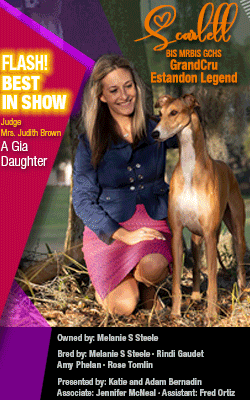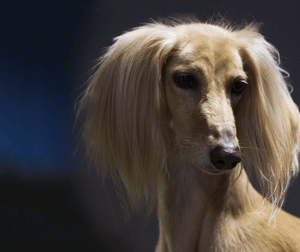Pinegrade Kennels and the Golden Age of the Sealyham Terrier

By Amy Fernandez
Mr. and Mrs. Frederic Brown epitomized the fabulously wealthy fanciers who launched the first wave of the rise of America’s purebred dog scene. Their success was largely built on the firm bedrock of British dog experts. Thanks to them, many breeds arrived prepackaged and ready to serve. Terriers, especially Airedales and Wires, dominated shows before World War I. Sealyhams were late arrivals to America’s sizzling Terrier scene. Nonetheless, they rode an unprecedented wave of popularity for decades.
A relatively new breed first shown in Britain in 1903, August Belmont, AKC president (1888-1916) set the pace for the breed in the US. He imported and registered the first Sealys in 1911 and founded the American parent club in 1913. The most significant pre-WWI arrival, Eng. Ch. Ivo Caradoc was imported by Ross Proctor for the staggering sum of £850. These weren’t capricious purchases. Seasoned pros like Len Brumby and Percy Roberts not only had access to premier stock in popular breeds, they knew what was trending, and back then it was Welsh Sealy stock.
In less than a decade, this obscure breed shot up the charts. By 1924, the first year AKC offered group competition, 30 Sealys competed at Westminster and Ch. Barberry Hill Bootlegger made history as the first to go Best. Sealy momentum continued. In 1926 Eng. Am. Ch. Pinegrade Scotia Swell won America’s first Terrier group show, Gwynedd Valley, the forerunner to Montgomery County KC. Swell was one of many Sealys imported by Percy Roberts for the Brown’s Bedford Hills, New York kennel. Percy knew his dogs, and that fact was categorically acknowledged a few months later at Philadelphia’s Sesqui-Centennial Expo Show. The “Sesqui” was part of America’s 150th anniversary celebration. Its record entry of 2899 made it the biggest show to date. Philadelphia was America’s Terrier stronghold and every handler came armed for ferocious competition.

In a surprise upset, Eng. Ch. Pinegrade Perfection won Sealys. “Bobbins” was a two-year-old white bitch Roberts selected for the Browns. But even he didn’t foresee her potential. He handed her off for Group competition and promptly placed second to Bobbins. A widely reprinted Edwin Megargee sketch captured the moment as Roberts with Bobbins under one arm, accepted the BIS trophy from Philadelphia mayor Freeland Kendrick, breeder of Queensbury Bull Terriers, and uncle of William Kendrick. Bobbins had gone BOS to kennelmate Scotia Swell at Westminster that year. In 1927, breeder Ross Proctor judged Sealyhams and he saw things differently. He clarified his BOB decision saying, “she entirely fulfills the demands of that group of breeders, who, in October 1922 drew up the revised standard for the Sealyham terrier.” That time, Percy stayed on her for Group, and went on to his second Westminster Best In Show in two years.
At Westminster 1928, Bobbins went Group Second to the Wire and eventual BIS winner, Ch. Talavera Margaret. But she ended her show career with a bang topping another record entry at Boston’s Eastern Dog Club that December. Unbeaten in her sex during her three year campaign, her record of six BIS doesn’t sound impressive today. But back then, there were approximately 150 shows annually with typical entries of 200-400 dogs. Bobbins won three of America’s biggest. Of course, Morris & Essex soon redefined big shows.
In 1930, the Browns triumphed again going BIS at M & E with another Percy Roberts import, Eng./Am. Ch. Delf Discriminate of Pinegrade. In 1932 he was part of Pinegrade’s Westminster BIS team along with their recently imported Eng. Ch. Rannerdale Sequence of Pinegrade. Paired with two Pinegrade homebreds, this team highlighted Pinegrade’s quality and consistency.
In 1935 Fredrick Jones profiled the Browns for the Gazette. Bobbins remained their favorite. “She is a trifle heavier today but at nearly 11 years of age she is still a remarkable Sealyham.” Jones noted Pinegrade’s record of 35 BIS wins during its 13 year existence. “The breed has developed a great deal in the last half dozen years and Pinegrade has done its full share. Their dogs are notable for substance, style, great coats, straight fronts, and marvelous bone.” However, the article was unmistakably their farewell.
Sealyhams rode a wave of success throughout the 1930s and ‘40s. In 1936, Ch. St. Margaret Magnificent of Clairedale became its third Westminster winner. But that didn’t happen again until Peter Green handled the Poole Forge import Ch. Dersade Bobby’s Girl to Best in Show in 1977.
The breed’s heyday came to a close but kennels like Clairedale, Robin Hill, and Poole Forge continued to showcase Sealyham quality. Most recently, Am ./Can./Swe. Ch. Efbe’s Hidalgo at Goodspice made history with BIS wins like the 2007 AKC/Eukanuba National Championship, the 2008 World Show, and Crufts 2009. Despite these remarkable achievements, Sealyhams never regained the prominence of those golden years before World War II.
Short URL: https://caninechronicle.com/?p=31471
Comments are closed












